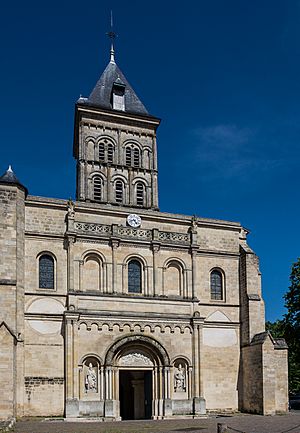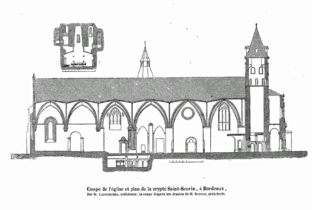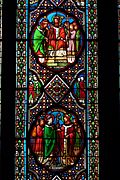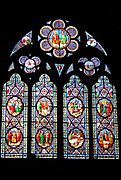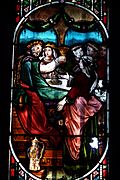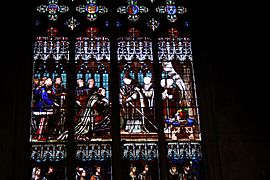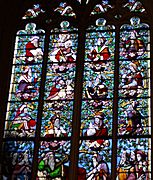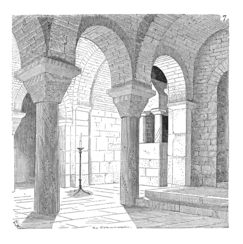Basilica of Saint Severinus, Bordeaux facts for kids
Quick facts for kids Basilica of Saint Severinus, BordeauxBasilique Saint-Seurin de Bordeaux |
|
|---|---|
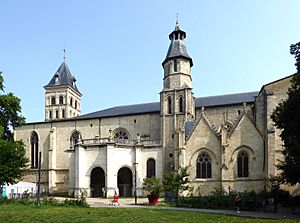
A view of the basilica from the Place des Martyrs de la Résistance.
|
|
| Religion | |
| Affiliation | Roman Catholic |
| District | Roman Catholic Archdiocese of Bordeaux |
| Location | |
| Location | Bordeaux, Gironde, Nouvelle-Aquitaine, France |
| Architecture | |
| Architectural type | Minor basilica |
| Architectural style | Romanesque |
| Groundbreaking | 11th century |
| Spire height | |
| UNESCO World Heritage Site | |
| Official name | Part of Routes of Santiago de Compostela in France |
| Criteria | Cultural: (ii), (iv), (vi) |
| Inscription | 1998 (22nd Session) |
The Basilica of Saint Severinus (in French: Basilique Saint-Seurin de Bordeaux) is a historic church in Bordeaux, France. Its story began in the 1000s, making it a very old and important building.
In 1998, UNESCO named it a World Heritage Site. This is a special title for places that are important to all of humanity. The basilica is part of a famous pilgrimage route called the Routes of Santiago de Compostela in France. Two other churches in Bordeaux, the Basilica of St. Michael and St. Andrew's Cathedral, also received this honor.
Contents
History of the Basilica
Ancient Origins
The basilica stands on a very old Christian cemetery that dates back to the 4th century. Archaeologists found a stone coffin lid from that time with a Christian symbol and writing on it. This proves that Christians lived in Bordeaux during the late Roman Empire. This ancient artifact is now in the Museum of Aquitaine in Bordeaux.
Legends of its Founding
The church is named after Saint Severinus, who was the fourth bishop of Bordeaux. One famous story, told by Gregory of Tours, says that the bishop of Bordeaux at the time, Amandus, had a dream. In the dream, God told him to go and meet a holy man named Severinus. When Amandus woke up and went out, he met Severinus, just as the dream had predicted. They greeted each other and went to the church together, and Severinus later became the new bishop.
Another legend involves the famous emperor Charlemagne and his nephew, the knight Roland. The story says that after Roland died in a great battle, Charlemagne brought Roland's special horn, called an Oliphant, to the basilica. He placed it on the altar as a tribute. This story made the church a popular stop for medieval pilgrims, who were people traveling for religious reasons.
Architecture Through the Ages
An Early Church
Even before the current basilica, there was a small church or chapel here in the 5th century. Sadly, it was destroyed during Viking raids in the 9th century.
The Romanesque Church (11th–13th centuries)
In the early 11th century, church leaders decided to build a new, grand church. They built it in the Romanesque style, which is known for its thick, strong walls and rounded arches. Because many pilgrims visited, the church was designed to guide them through the main area and down into the crypt, where holy relics were kept.
In the 13th century, a beautiful southern entrance was added. It has a porch and a bell tower. A grand Gothic-style entrance was also built for the cemetery. This entrance features 14 carved statues of the twelve apostles and two female figures. The carvings above the doors show scenes from the Bible, like the Resurrection of Jesus.
Changes and Additions (14th–18th centuries)
During the 14th and 15th centuries, several small chapels were added to the church. One of the most beautiful is the Chapel of the Madonna of the Rose, which was blessed in 1444. It was built in a fancy Gothic style.
Unfortunately, parts of the church's ceiling collapsed twice, in 1566 and 1698, causing a lot of damage. In the 18th century, an architect named Jean-Baptiste Augier was hired to fix it. He added strong stone supports. During the repairs, the floor was raised by almost three meters. This buried the original crypt and changed the look of the 11th-century entrance.
The 19th-Century Makeover
The basilica survived the French Revolution, but the 1800s brought big changes. The front of the church, called the western façade, was rebuilt in a Neo-Romanesque style to look like the original.
A famous sculptor, Dominique Fortuné Maggesi, was hired to decorate the new front. He carved statues of Saint Severinus and Saint Amand for the entrance. He also added statues of Saint John and Saint Peter higher up on the building.
In 1840, the basilica was officially listed as a Historic Monument of France. After this, the church's main altar was replaced with a new one made of marble. New chapels were built, and beautiful stained-glass windows were installed. These windows, made by Joseph Villiet, show scenes from the Bible and stories about the basilica.
Treasures Inside the Basilica
Many of the church's original medieval items were lost over time. However, some amazing treasures still remain.
- Altar Pieces: The church has several alabaster (a type of soft, white stone) altar pieces from the 15th century. One in the Chapel of the Madonna of the Rose shows scenes from the life of the Virgin Mary.
- Bishop's Chair: A special wooden chair for the archbishop of Bordeaux, made in the 15th century, is still in the church. Before a new archbishop can take office, he must come here and take an oath.
- Choir Stalls: The choir has 32 of its original 47 wooden seats from the 15th century. These seats, called stalls, are decorated with carvings of saints and other figures.
- Statues: The basilica has several well-preserved medieval statues, including a 14th-century alabaster statue called Our Lady of the Rose.
Sadly, Roland's famous Oliphant horn, which was kept in the church for centuries, disappeared sometime before the French Revolution.
The Crypts Below
A crypt is an underground room, often used for burials. The basilica has two important crypts.
The Church Crypt
This crypt is part of the original 5th-century building. It contains stone coffins, known as sarcophagi, which are said to hold the remains of early bishops of Bordeaux. For a long time, people believed that bringing young boys to the tomb of a martyr named Saint Fort would make them strong.
The Archaeological Crypt
This crypt is what remains of the ancient Christian cemetery. According to legend, this cemetery was so special that it was blessed by Christ himself. This made it a very important burial place and a popular destination for pilgrims in the Middle Ages. Excavations in the 1900s uncovered graves from the 4th to the 13th centuries. Today, visitors can go down into the crypt to see this ancient site.
The Basilica Today
In recent years, the basilica has been carefully restored. The roof, walls, and chapels have all been repaired. During a restoration of the Gothic entrance in 2005, workers discovered traces of the original paint. This exciting discovery helps us imagine how colorful and vibrant the entrance looked when it was first built.
See also
 In Spanish: Basílica de San Severino (Burdeos) para niños
In Spanish: Basílica de San Severino (Burdeos) para niños


